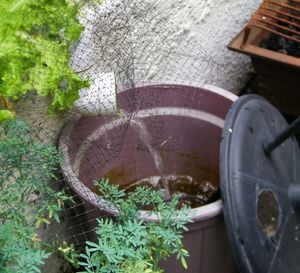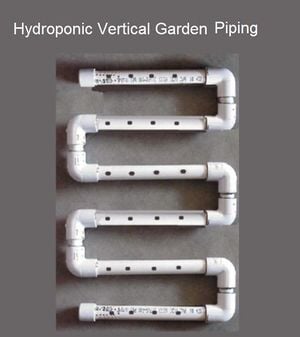
The benefits of urban gardening include adding: educational, food providing, therapeutic, and community strengthening green spaces. Urban gardens differ from their rural counterparts by usually benefiting from: a frost free season as well as an extended growing season for one month due to the urban island heating effect; a reduced number of predatory wildlife (like deer, coyotes, and moles); an increased incentive for creativity within the smaller space.
However at the same time urban gardens have different obstacles than their rural counterparts. Some of these obstacles include: confined spaces, blocked sunlight, poor soil, unreliable water access, soil and air pollution, as well as theft, vandalism, and politics to further complicate things.[1]
In response to the problems faced with blocked sunlight, confined spaces, and poor soil Sembradores Urbanos has contructed a hydroponic vertical garden. This is one project in a series of urban gardening projects at Sembradores Urbanos.
Background[edit | edit source]





Vertical gardening helps you make the best of the light you have and optimize on the vertical space available in condensed areas. Traditionally vertical gardening includes trellising, terracing, or tumbling.
- Trellising includes having crops that like to grow vertically up poles like: snow peas, pole beans, and cucumbers.
- Terracing, in an urban environment, includes staking plants in a stair step sequence in containers.
- Tumbling includes plants that grow well in hanging planters and let their leafs sprawl toward the ground: like tomatoes, strawberries, cucumbers, and thyme.[2]
The hydroponic vertical garden can be considered somewhat of a terracing strategy, however the stacking does not occur in a stair sequence, but rather goes straight up, since the PVC container can be mounted to the wall.
Lighting[edit | edit source]
Lighting is either:
- Full sun: 6 to 8 hours of sun per day. In warm climates some plants only need 6 hours, while in cold climates they need 8hrs.
- Partial sun: direct sun for a shorter period or dappled sun through the leaves of an overhanging tree.
- Full shade: sunless conditions
Plant preferences for lighting[edit | edit source]
- Tomatos and cucumbers want full sun
- Beans and peas can do with any where from full sun to partial sun
- Root vegetables like radishes and potatoes can do with partial sun
- Leafy greens like spinach and chard can deal with very little sun
- Onions like full light for mature bulbs, but scallions (or baby onions) can be grown in less light.[2]
Designing with light in mind[edit | edit source]
First of all, you must know how much sunlight your garden gets and what areas receive more. This means being patient and watching, take one day to record how the sunlight shifts over your garden. Draw a simple sketch of your garden and break up your garden into a graph, with separate sections. Write down how many hours and minutes of direct sunlight each section receives. At what time does your garden receive the light? You can get as specific as you want, but at least find out if your garden gets more sunlight in the morning or in the afternoon and roughly where. This will help you organize your plants in those areas with the needed sunlight availability.[2]
In México, where Sembradores Urbanos project takes place, the best location for a garden is on the south or west side of a house or building, where the sun is more prevalent. If some part of your garden space is too shady you can place your compost pile or chicken and duck pen there.
Urban soil[edit | edit source]
Urban soils are often either paved over and not available or they are heavily contaminated. The most common urban soil contaminants are high levels of lead, cadmium and mercury. They are also often compacted, clayey, and contain a high metal content.
Options for soil[edit | edit source]
- Avoid contaminants:
- Reduce the amount of lead that plants absorb by adding mulch and organic mater.
- Grow food plants away from the road to prevent plants from taking up lead.
- Keep pH higher then 6.7 to prevent plants from absorbing lead.[1]
- Remediating soil: Use mushrooms or vegetation to turn brown soils into productive restored soils.
- Creating soil: Compost food scraps, adding peat moss, and aged saw dust to create soil. You can add this soil to containers or to raised beds.
- Hydroponics: Go without soil and instead place plant roots in water with added nutrients needed for growth. This can be a bit trickier since soil contains a variety of properties still not completely understood by science and thus not easily repeated in nutrient mixes.[1]
Benefits of hydroponics[edit | edit source]
- No tilling, no digging, no hoeing, no raking. Since hydroponics is without soil and instead in a watery medium there is no need to do tilling or other similarly laborious tasks.
- No Crop Rotation and no fallow land. The watery medium can easily have nutrients added to renew the lost nutrients, while soil needs to regenerate either through crop rotation, where different plants can give and take different nutrients from the soil, or through fallow land practices, where one waits a year or more till using the land again for agriculture.
- Weeds are Easily Dealt with. Those weeds that do become established in your hydroponic system are much more easily removed since their roots are suspended in water and can be removed as a whole, where as the roots of weeds in soil can become deeply rooted in the soil and difficult to remove totally without digging them up.
- Resulting Fruiting and Flowering bodies are relatively Uniform. Where soil varies greatly over an acre in nutrient, mineral, and clay content, the water substrate in hydroponics can easily and quickly distribute nutrients uniformly throughout to all plants in the system, leading to much more uniform results.
- Increased Food Consumption Safety when applying animal and human waste fertilizers. In hydroponic systems the application of animal or human waste as nutrient fertilizers can be done in a location that does not need to come in to contact with the leaves or fruiting body of the plant at all and easily diffuse through the entire system. Unless using drip irrigation or applying the fertilizer before planting, animal and human waste fertilizer application on soil usually will come in to contact with the leaves or fruiting body of low lying plants like lettuce or strawberries and can easily cause dysentery problems unless properly sterilized.
- Optimizes on Space, with Increased Yield per Area. Plants can grow closer together and thus the yields can increase per area.
- Better Control of pH.[3]

Hydroponic plant food[edit | edit source]
Usually these mixes are made of a balance of at least 6 macro and 6 micro elements. The 6 macro elements are nitrogen(N), phosphorous(P), potassium (K), calcium, magnesium, and sulphur. The 6 micro elements are iron, maganese, boron, copper, zinc, and molybdenum.[3]This list is continually being extended as new elements and exiting elements roles within soil are better understood by science. There are different N:P:K ratio's recommended specific for each crop and for different stages of growth including: seedlings stage, vegetative stage, and flowering and fruiting stages. So your mix should change depending on the plant and the stage its in. You might also have better results if you grow plants that require the same nutrient strength within the same system, that way some plants aren't going without and others with excess.
Preprepared synthesized chemical hydroponic mixes leave it all up to the scientists, but leaving it all up to science isn't always the best idea, when science doesn't know everything, especially about soil. This lesson can be seen in baby formula mixes that are continually changing to add the next nutrient or vitamin forgotten the previous year and found to be intensely important for brain development or growth, like DHA, ARA, 4 different kinds of vitamin E, and 5 different kinds of vitamin A.[4] Rather then simply rely on synthesized chemical mixes to meet all your needs, its important to at least hybridize your mix so that you are adding at least some organic nutrients. This can help prevent your plants from going without an important mineral or nutrient not yet understood, but found in nature and completely important for a functioning and optimum growth system.
References[edit | edit source]
- ↑ 1.0 1.1 1.2 Fern Marshall Bradley, Barbara W. Ellis. Rodale's All-New Encyclopedia of Organic Gardening: The Indispensable Resource for Every Gardener. Rodale, 1993. Pg 704.
- ↑ 2.0 2.1 2.2 Ruppenthal, R. J.Fresh Food from Small Spaces: The Square-Inch Gardener's Guide to Year-Round Growing, Fermenting, and Sprouting. Chelsea Green Publishing, 2008.
- ↑ 3.0 3.1 Dudley Harris. Hydroponics: the complete guide to gardening without soil. Struik, 1992
- ↑ Linda Folden Palmer.The Baby Bond: The New Science Behind What's Really Important When Caring for Your Baby. Sourcebooks, Inc., 2009